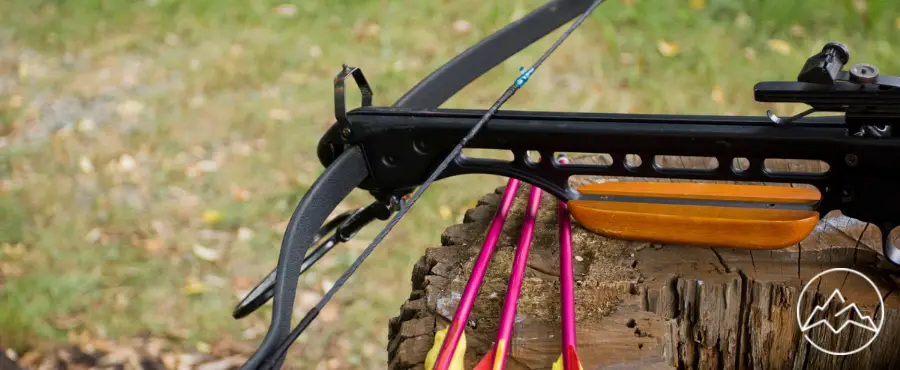
If you’ve spent any time around crossbow enthusiasts or hunters, you’ll know there’s one fundamental rule when using a crossbow. Never dry fire your crossbow! It can cause severe damage in no time at all. There is a reason crossbows come with warnings.
If your crossbow doesn’t have an anti-dry-firing mechanism, accidents can happen. But dry firing accidents can almost always be avoided by using your crossbow correctly. If you want to avoid replacing your crossbow, you must understand what dry firing is and how it impacts your crossbow.
What is dry firing?
Simply put, dry firing is releasing a cocked crossbow string when it isn’t loaded. It sounds pretty harmless, but if you’re familiar with how crossbows work, you’ll know it’s anything but. Cocking the crossbow causes it to store energy in the limbs; when the string is released, it becomes active kinetic energy that is transferred to the crossbow bolt and propelled forward.
Firing your crossbow without a bolt causes the limbs and string to vibrate powerfully. Still, the built-up energy has nowhere to disperse, redirecting the kinetic energy into the bow in a violent shockwave. Firing a bolt causes little vibrators in a bow, but dry firing causes extreme vibration and stresses the string and limbs. One single dry fire can be damaging enough to necessitate a crossbow replacement.
Why does dry firing happen?
Most of the time, dry firing is an accident. These can occur because of an innocent mistake, such as a string slip or an incorrectly nocked bolt. Too light of a bolt can cause dry firing because the bolt doesn’t absorb enough energy. Inexperienced users are prone to dry firing crossbows; sometimes, they are trying to avoid damaging an arrow by shooting it at the ground. Occasionally, a novice may think that it’s easier to learn to aim without a bolt and will fire a cocked bow. This is not ideal. It’s a big mistake to dry fire your crossbow deliberately, and you may find yourself replacing it sooner rather than later. You’ll have to spend your hard-earned cash paying for a professional repair, or you’ll need to replace the entire crossbow. Regardless, you shouldn’t dry fire your crossbow. Field tips can prevent wear and tear on your more expensive fixed blade broadheads if you need to use an arrow to decock your bow.
The consequences of dry firing a crossbow
More modern crossbow models have special anti-dry firing mechanisms to prevent you from dry firing your crossbow. But if you do dry fire your crossbow, the impact is swift and unmistakable. The limbs aren’t designed to absorb excess energy. You’ll release tons of power when you let go of the string. A loud snap can follow when you do this without a bolt nocked, and the result isn’t nice. Sometimes, you’ll be forced to replace it immediately.Here are three things that can happen to your crossbow if you dry fire it:
- The limbs crack or shatter: Limbs, particularly laminated composite limbs, can become delaminated, crack, snap, or splinter.
- String damage is an immediate result; your string could become fuzzy/frayed or snap totally.
- Nothing: If you’re fortunate, nothing obvious will happen. Still, check your bow thoroughly – or better yet, have a professional do it before you use it again.
During a dry fire, your crossbow limbs can become irreparably damaged and splinter or crack. Kinetic energy forced back into the bow can damage the string and cams. If the cam is damaged, the string will vibrate away from the cam tracks, and eventually, the string will snap due to the stress. The cams can leave indents and cracks in the limbs at this point. I’ve seen bows come apart with broken pieces flying off in all directions in severe cases. Sometimes nothing obvious happens after a dry fire, but that doesn’t mean you’re safe. You’ll need to inspect your bow for damage. Component failure is all but certain, and you may experience some damage after the next time you fire a bolt.
What to do after dry firing
Upon experiencing a dry fire, you should prioritize your bow. Scrutinize your bow and assume that damage has occurred even if there’s no visible damage. Minor damage can quickly become irreparable if it’s not detected. Here’s a list of areas to inspect in the case of a dry fire:
- Cams
- Riser
- String
- Cables
- Limbs
If you have a recurve bow, you’ll want to inspect the limb tips too to ensure the loops are still securely attached to the tips. If you have a compound bow, you should carefully inspect the riser and cams for cracks, bends, or other damage. Also, ensure that the cables and string are slotted correctly. Check the limbs for chips or splinters. You can use a cotton ball rubbed over the edges and surfaces to detect flaws in the limbs. The cotton ball will usually make it obvious if you have any splinters or cracks. Follow up by rubbing your fingers along the cables or rings to check for tension and loose strands.
After inspecting your crossbow, you should test your crossbow. Cock the crossbow carefully and listen for any strange sounds – if it sounds normal and feels normal, fire off a practice bolt to test the aim/in-flight trajectory. If you’re unable to aim correctly, that may be a sign of damage. A final step is to take it to a professional, such as a pro archery shop, and get it inspected. It’s much better to identify and repair damage in the first instance than it is to wait until later.Check out our Complete Guide to Crossbow Hunting here


